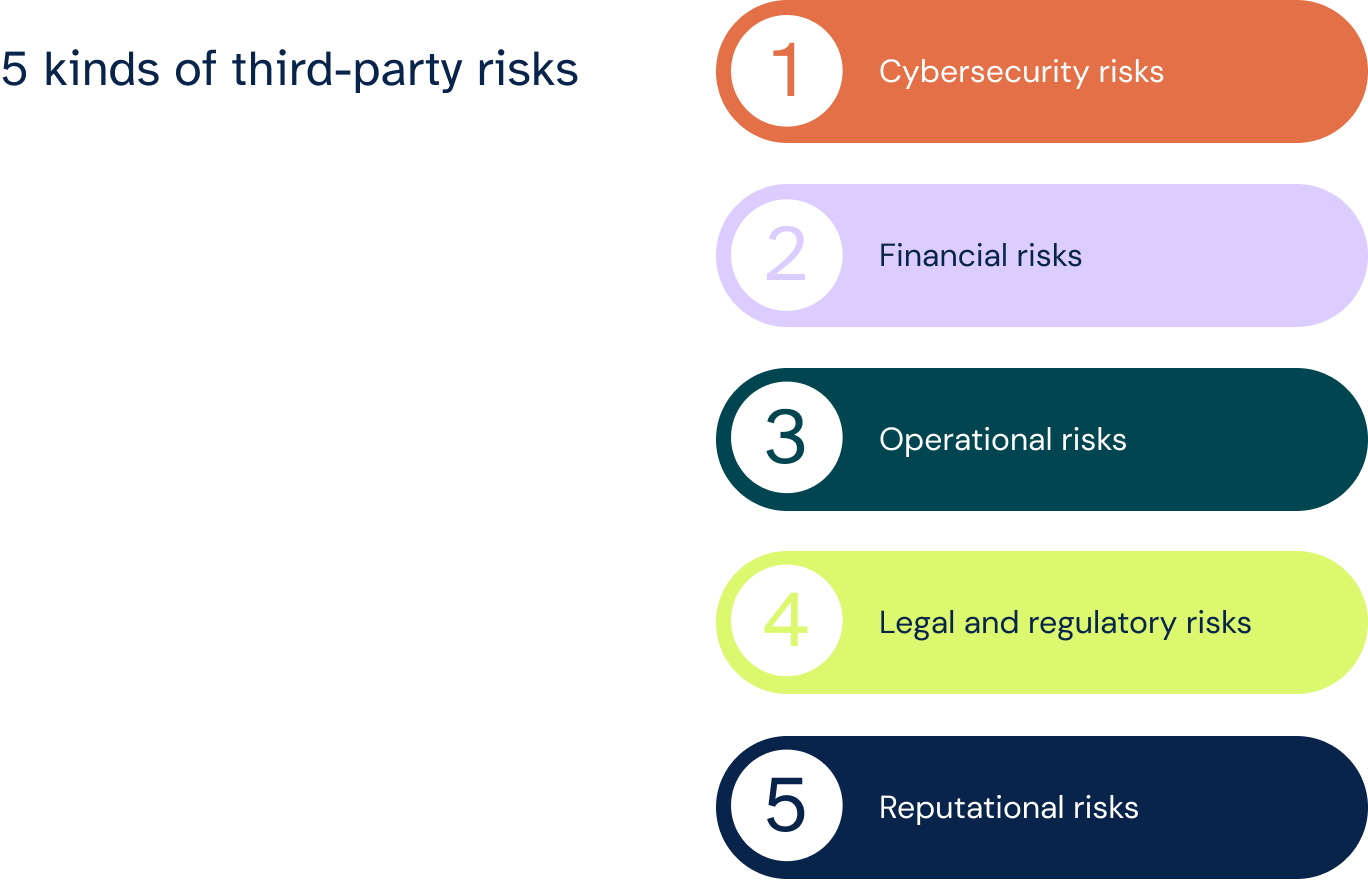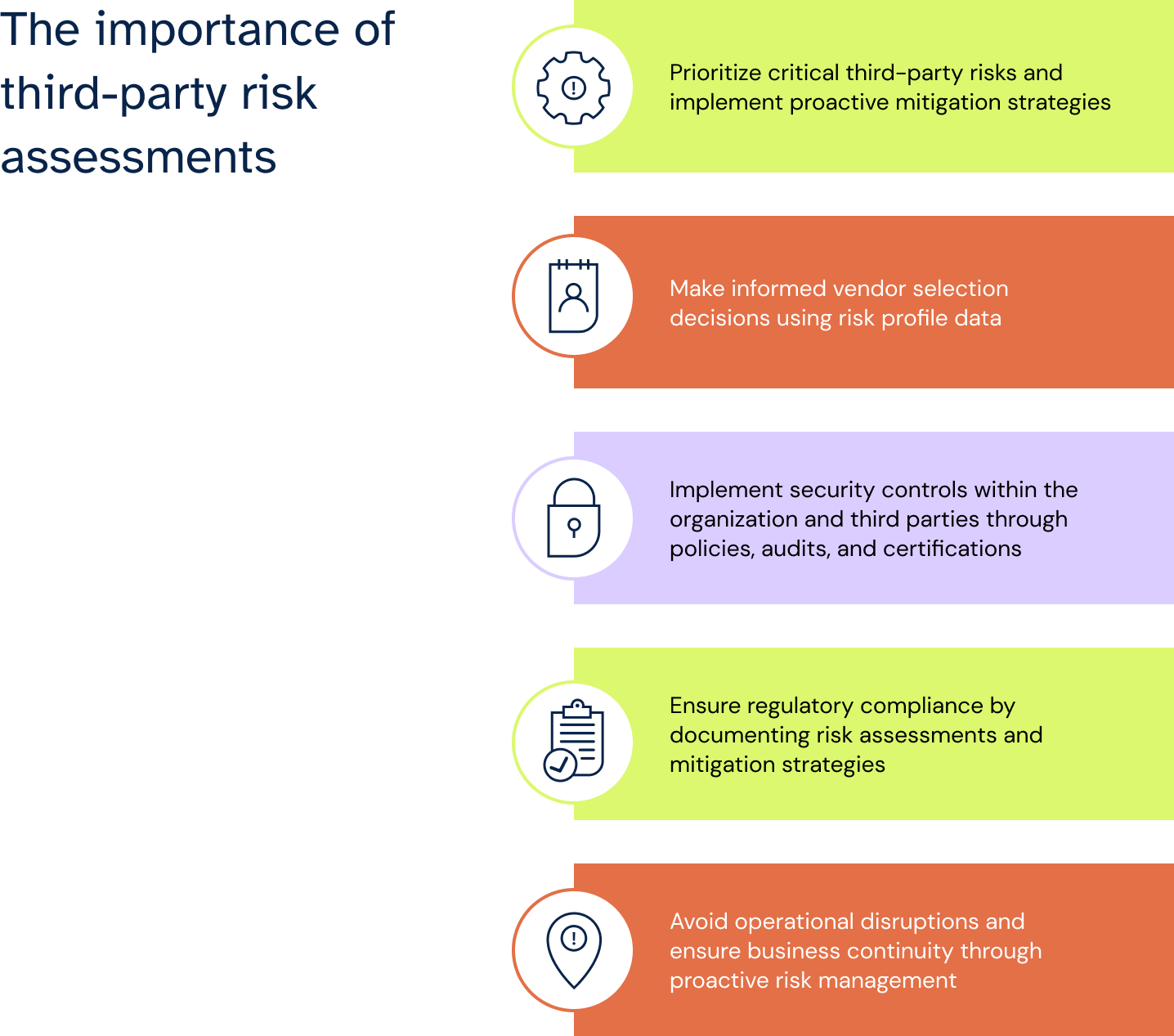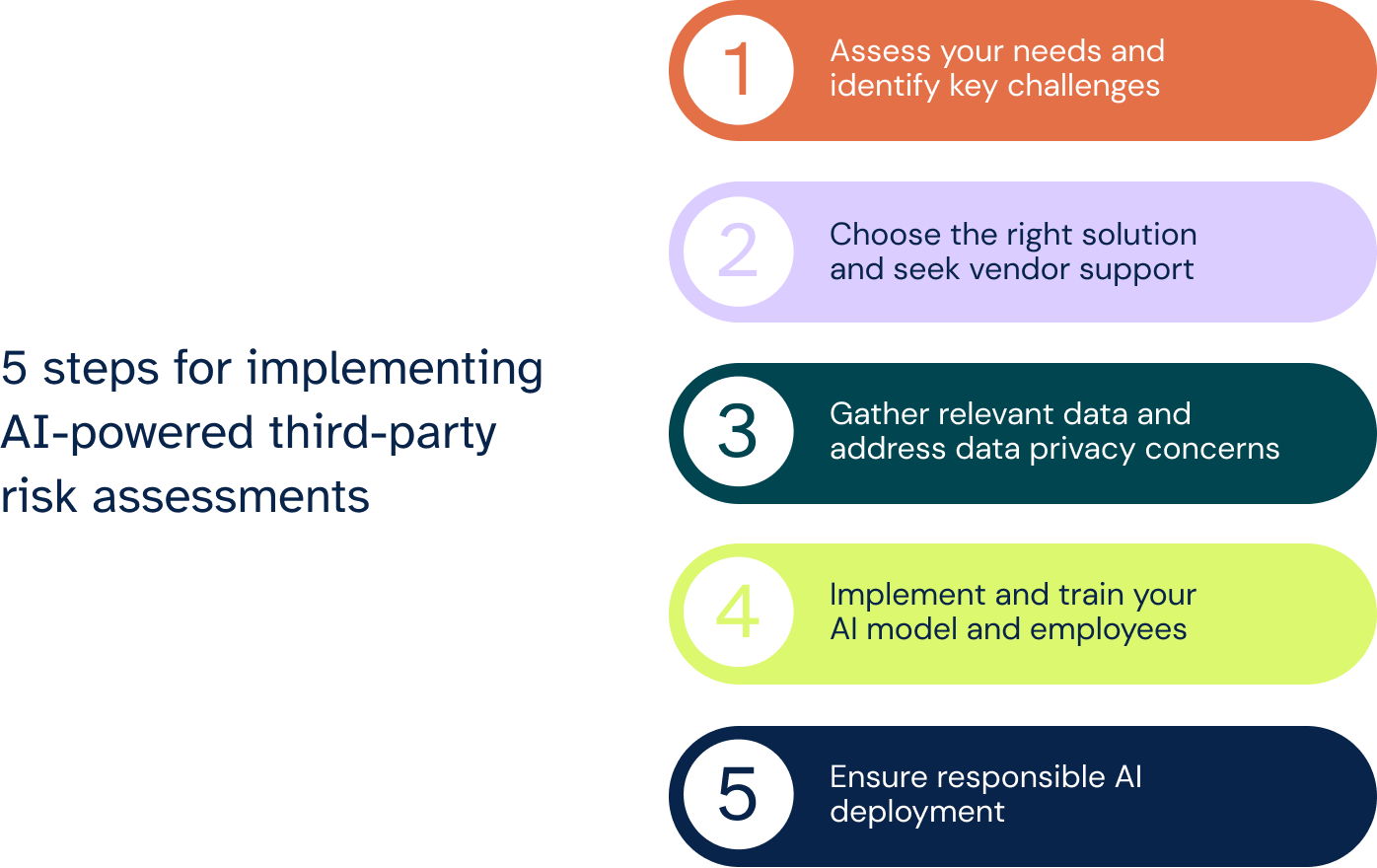Today, organizations rely heavily on third-party vendors and partners for business operations. While these partnerships can foster innovation and expansion, they also introduce significant cybersecurity risks if not effectively managed.
Recent high-profile data breaches, such as the 2022 Uber breach, have highlighted the dangers of supply chain attacks and vulnerabilities associated with third parties. To combat this, many companies are adopting AI-powered solutions for automated assessments of third-party risks to address these risks.
Today, we will look into AI-powered third-party risk assessments, their importance and implementation, and what 6clicks offers for risk assessments.

Understanding third-party risk
Third-party risk refers to the potential threats and vulnerabilities that can arise from the use of external parties, such as suppliers, vendors, or contractors, who have access to your organization's sensitive data or systems. These third parties may introduce risks that can compromise an organization's data's confidentiality, integrity, or availability. Third-party risks also encompass various potential threats, including:
- Cybersecurity risks: Data breaches, unauthorized access, malware infections, system disruptions.
- Financial risks: Payment fraud, contractual disputes, supplier insolvency, economic instability.
- Operational risks: Service disruptions, supply chain disruptions, quality issues, production delays.
- Legal and regulatory risks: Non-compliance with regulations, environmental concerns, and data privacy violations.
- Reputational risks: Negative publicity, brand damage, loss of customer trust due to third-party misconduct.
Third-party risk management (TPRM) involves identifying, evaluating, and monitoring risks associated with vendors, suppliers, partners, and other entities within a business ecosystem. Traditionally, TPRM programs have relied on manual questionnaires and processes that are time-consuming, subjective, and provide only a limited snapshot of risk. However, artificial intelligence solutions are revolutionizing this approach by continuously monitoring third parties and providing objective, data-driven risk ratings.
As threats to supply chains and third-party ecosystems continue to evolve, organizations must prioritize modernizing their TPRM programs. AI-powered solutions offer the scalability, automation, and insights necessary to proactively identify and mitigate cyber risks associated with third parties in today's dynamic business environment.

The importance of third-party risk assessments
Third-party assessments are pivotal in protecting your business from potential threats and vulnerabilities. They systematically evaluate the possible harm you could face from engaging with vendors, suppliers, service providers, and other external entities.
Here's an overview of what makes TPRAs important:
- Help discover and understand risks associated with third parties, like cyber threats, financial issues, disruptions, compliance, and reputation.
- Prioritize critical third-party risks and implement proactive mitigation strategies.
- Make informed vendor selection decisions using risk profile data, allowing you to choose partners with robust security and financial stability.
- Implement security controls and best practices within the organization and third parties through policies, audits, and certifications.
- Ensure regulatory compliance by documenting risk assessments and mitigation strategies.
- Avoid operational disruptions and ensure business continuity through proactive risk management.
- Prevent costly incidents like data breaches, service failures, and legal issues. The cost of TPRA is minor compared to potential losses.
- Protect brand reputation by identifying and avoiding unreliable third parties.
Remember, TPRAs should be conducted regularly throughout the lifecycle of a third-party relationship to ensure continuous monitoring and risk management.

Introducing AI-powered third-party risk assessment
Organizations are turning to AI-powered solutions to enhance third-party risk assessments. AI-powered TPRAs use artificial intelligence technology to automate, enhance, and refine the traditional TPRA process. They take various forms, incorporating different AI techniques, but offer several key advantages:
- Analyzes large amounts of data from various sources to automate risk analysis, saving time and resources.
- Automates repetitive tasks, allowing humans to focus on critical thinking and decision-making.
- Identifies complex risk patterns and emerging threats that humans may miss.
- Analyzes unstructured data like social media to gain insights into reputation, legal disputes, etc.
- Enables real-time monitoring and alerts about changes in third-party risk indicators.
- Uses predictive models to assess the likelihood and impact of different risks, allowing for prioritizing high-risk vendors.
- Offers data-driven insights to help experts make informed decisions about third-party relationships.
However, it's crucial to remember that AI is not perfect. AI models are only as good as the data they are trained on. Ensuring the quality and relevance of training data is critical for accurate results. AI can also introduce bias if not carefully monitored.
Transparency and explainability are also important. Ensure you understand how AI models generate risk scores and avoid "black box" algorithms. Regular checks and ethical considerations are essential for responsible AI adoption.
By harnessing the power of AI, businesses can gain deeper insights into their third-party relationships, identify emerging risks, and make data-driven decisions to mitigate those risks effectively. AI-powered risk assessment saves time and resources and improves an organization's overall risk management capabilities.

Implementing AI-powered third-party risk assessment
Integrating AI-powered third-party risk assessments can enhance efficiency and effectiveness, but implementing it requires careful planning and execution.
AI-powered third-party risk assessments often start by assessing your needs, which involves identifying key challenges. Are you overwhelmed with manual tasks, struggling to find hidden risks, or facing difficulty prioritizing vendors?
It also encompasses defining your goals. What specific improvements do you aim to achieve with AI? Do you want increased efficiency, deeper analysis, or predictive risk insights? In the first stage, evaluating data readiness is also crucial. Do you have access to high-quality, relevant data for AI models to train on?
After assessing your needs, it's time to pick the right software or solution. Explore different AI-powered TPRA solutions. Compare features, pricing, and capabilities to find one that aligns with your needs and budget.
You should also consider the level of AI integration. Some solutions offer standalone modules, while others integrate seamlessly with existing TPRM platforms. Seeking vendor support is another key strategy. Look for providers with experience in your industry and expertise in responsible AI implementation.
Next comes preparing your data. Gather relevant data, including financial reports, vendor questionnaires, news articles, social media data, and regulatory compliance information. Ensure consistent formats and eliminate errors for efficient AI analysis. It's also best to implement responsible data handling practices and obtain necessary permissions for using third-party data.
Once you've prepared your data, it's time to implement and train it. Start with a limited scope to test its effectiveness and identify integration issues. Moreover, train your team to ensure everyone understands the AI's role in third-party risk assessments and how to interpret its outputs. Don't forget to regularly evaluate its performance and adjust settings or models as needed.
Lastly, ensure responsible use. Monitor for potential biases in your data and algorithms to avoid discriminatory outputs. Be transparent, explain how AI contributes to risk assessments, and communicate its limitations. Remember, AI should complement, not replace, human expertise, so ensuring human involvement in critical decision-making is another crucial step.
Automate third-party risk management
As the frequency and impact of cyber threats continue to increase, organizations must prioritize third-party risk management. Traditional manual processes are insufficient in today's complex and fast-paced business ecosystems, as they are slow and limited in providing adequate protection. Therefore, adopting AI-powered solutions has become essential in managing these risks.
AI-powered platforms with advanced analytics, automation, and continuous monitoring capabilities enable proactive management of third-party relationships. Organizations can identify their most risky vendors and partners by evaluating financial risk, cyber posture, and compliance on an on-going basis, taking a more proactive approach. That allows them to enhance security controls before any potential breach occurs.
Furthermore, AI systems offer scalability and objectivity, making it easier to conduct audits, generate reports, and benchmark third-party risks across the organization. Security and GRC teams gain comprehensive visibility and can effectively communicate insights to leadership, thereby driving strategic decision-making.
By leveraging AI-powered third-party risk management, organizations gain actionable intelligence to protect their data within the digital supply chain. As threats become increasingly sophisticated, companies without AI capabilities will struggle to comprehend and mitigate third-party risk. Embracing AI-powered solutions empowers organizations to confidently engage with third parties, creating business value while safeguarding their most critical asset — their data.
On the respondent's side, they can use LLMs and generative AI to help automate the response of assessments by leveraging historical assessment responses and related data, which helps expedite and automate time-consuming inbound vendor assessments while ensuring accuracy across responses.
6clicks' Hailey GPT for audits and assessments
6clicks’ Third-Party module is built for vendor risk management and managing your third parties. With custom business-facing onboarding forms, bulk and automated assessment capability, and workflows, we have everything you need to identify and manage risks and areas of non-compliance across your third-party ecosystem.
For respondents, 6clicks' Hailey GPT for audits and assessments — our generative AI tool that expedites audits and assessments by learning from historical responses and your team's data — is here to help you.
Hailey GPT for Audits & Assessments offers automated audit and assessment responses based on your data and historical responses, greatly enhancing the speed and ease of the response process. You can quickly respond to inbound audits and assessments, saving precious time lost in manual information collection.
Bring consistency and accuracy to your responses today with 6clicks' Hailey.
Experience a demonstration of how our AI-powered platform for cyber risk and compliance can help you.
Leverage the power of generative AI to respond to your audits and assessments at the click of a button.
Written by Greg Rudakov
Greg is a Senior Product Manager at 6clicks, spearheading the growth and development of the company's groundbreaking Hailey AI engine. Greg's impressive track record includes founding a successful SaaS venture, leading major projects for companies such as KPMG, and integrating IT systems and teams across the globe. With a keen focus on go-to-market strategy and collaboration amongst senior leadership and customers alike, Greg continues to elevate 6clicks' position as a leader in AI-driven solutions for risk management and compliance.








